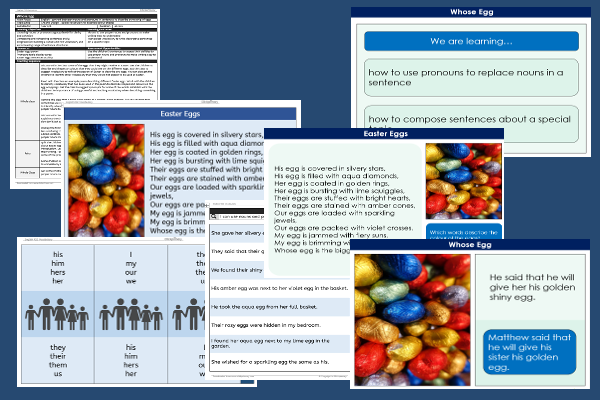Home > Key Stage Two > English > Extra > Easter Eggs
Lesson Three – Whose Egg

This English teaching pack for Key Stage Two gets the children to explain and model how to convert between nouns and pronouns in different example sentences to describe ownership of a range of Easter eggs.
The class can practise writing sentences using pronouns and proper nouns for clarity about Easter eggs to indicate clearly who each egg might belong to in a family.
Download this teaching pack including a lesson plan, classroom activities and an interactive presentation to explain and model how to convert between nouns and pronouns in different example sentences to describe ownership of a range of Easter eggs
Activities in this teaching pack include a shared reading text to identify and define vocabulary used to describe nouns in a poem about different Easter eggs, a table display card to select a range of pronouns to use in sentences replacing nouns about different Easter eggs and a worksheet to model how to use proper nouns to replace pronouns when improving the clarity of sentences.
The interactive presentation gets the children to explore how to convert between nouns and pronouns in different sentences to describe ownership of a range of Easter eggs.
This lesson is part of an English scheme of work to get the children to select and use descriptive vocabulary to create a shape poem describing different types of eggs given for Easter. There are teaching activities for shared learning, differentiated worksheets to support independent learning and interactive presentations to introduce concepts and key skills.
-

Length Calculations
Practise using number calculations skills for addition, subtraction, division and multiplication when solving problems related to length measurements
-

Maths Calculations Assessment
Assess abilities in solving a range of different number problems for addition and subtraction when working with informal and formal written calculations
-

Determinant Lists
Explain and model how to make lists of objects used and found in different locations to match the correct determinants of a and an
-

English SPAG Assessment
Assess abilities in composing sentences for fiction and non-fiction using the correct spellings, punctuation marks and grammar vocabulary phrases
